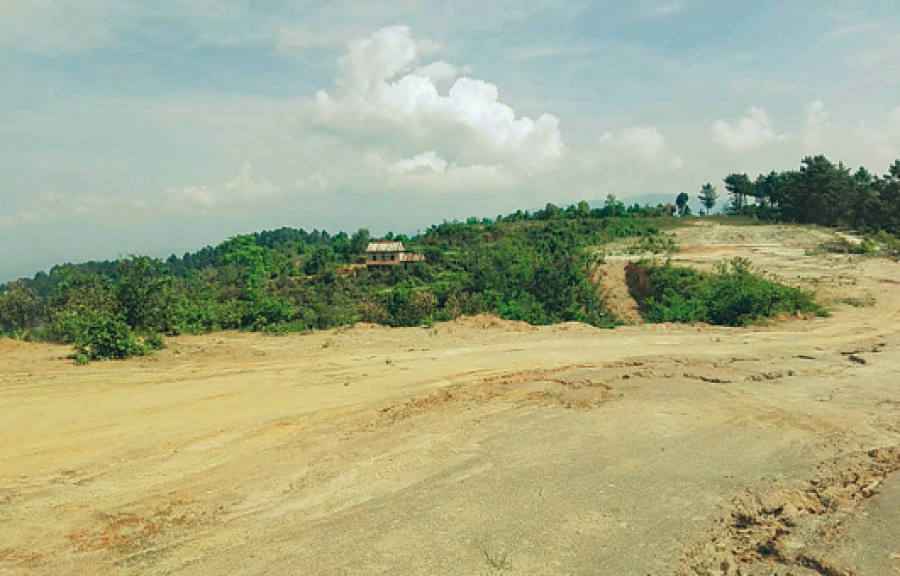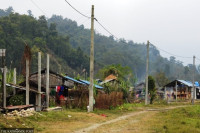National
A domestic airport in Kavre: A flight of fancy or need of the hour?
A preliminary survey estimates the airport, with a tabletop runway of 1,200 metres, will cost Rs 16 billion. Aviation experts say an airport near Kathmandu was needed a decade ago, not now.
Sangam Prasain
Nepali politicians are quite given to flights of fancy. Building airports in their constituencies, hence, is their oft-repeated promises, especially during election campaigns. As a result, most of the airports are carved out of a mountain, without any study whether it is technically or financially feasible, which eventually turns into pastures, aviation experts say.
When Gokul Prasad Baskota, a Nepal Communist Party leader, who in 2017 was contesting the parliamentary elections on the then CPN-UML ticket from Kavre constituency, among other promises, he told his voters that he would build an airport in the district.
Baskota, a trusted lieutenant of then UML chair KP Sharma Oli, won the election. Oli became prime minister and as his close aide, Baskota enjoyed significant clout in decision-making processes. Oli in June 2018 appointed Baskota minister for communication and information technology. He was forced to resign on February 20 over a corruption scandal.
He, however, managed to secure his dream project.
Officials familiar with the development say a preliminary survey has been conducted by the Japan International Cooperation Agency (JICA) for an airport in Nagidanda of Kavre. With the cost estimated at Rs 16 billion, if constructed, it will become the most expensive domestic airport, with a 1,200-metre-long runway, in the country, according to the officials.
Aviation experts, however, are questioning if a domestic airport in Nagidanda, just 8.5 nautical miles or 16 kilometres from Kathmandu's Tribhuvan International Airport, is indeed needed.
“A small domestic airport near Kathmandu was planned years ago to reduce the congestion at Kathmandu's airport so that all Lukla flights could be diverted there,” said an official at the Civil Aviation Ministry who spoke on condition of anonymity. “But the situation is different now. The airport was needed a decade ago. Not now.”
During the peak season, swarms of trekkers and mountaineers headed for Everest keep Kathmandu’s airport constantly busy. Lukla has even witnessed as high as 200 take-offs and landings on a single day. In such a situation, if a flight were to be disrupted due to bad weather in Lukla, rescheduling it would create massive chaos at Kathmandu, hampering the operation of international flights as well.
“Now, with a second international airport in Bhairahawa set to come into operation, which will also serve as the gateway to the birthplace of Buddha, by the beginning of next year, we don’t need a domestic airport close to Kathmandu because some international traffic will divert there,” said the official. “Meanwhile, another international airport in Pokhara will also be ready by the mid-2021.”
The plan to construct a new domestic airport near Kathmandu–and Kavre as the suitable location–was originally floated in view of the proposed Nepal Tourism Year 2011 by the then tourism minister Hisila Yami in 2009. Three successive tourism ministers spoke about building it, but they all eventually abandoned the scheme because of the frequent change in government.
After the Oli government took office, Baskota revived the plan in 2018. He has been lobbying for building the airport in his home district for a long time, according to officials familiar with the development.
One official said that JICA conducted the survey on its own after getting the nod from the finance and civil aviation ministries. “The cost estimate as per the preliminary reports is simply outrageous,” the official told the Post.
The construction amount for the airport, which will be suitable only for short takeoff and landing (STOL) aircraft, is Rs7 billion more than the cost of the international airport project in Bhairahawa and Rs5 billion less than the under-construction international airport in Pokhara.
The Nagidanda hilltop has 84 hectares of land, 22 hectares of which is privately owned. Millions of cubic metres of soil will need to be moved to level the construction site, according to the internal survey of the Civil Aviation Authority of Nepal, which was conducted by Realpath Engineering Consultancy of Nepal in 2018. At some places, 500-metre-deep ravines need to be filled with earth by cutting away parts of nearby hills.
According to the new JICA survey, Rs 6 billion alone would be required for soil filling works. The airport will be on a plateau or the hilly surface which means it will have a “tabletop runway” with both ends overlooking a drop, and such airports are considered risky in the aviation industry.
On August 7, at least 18 people died in southern India after a Boeing737 of Air India Express overshot a runway at Kozhikode in Calicut, known as a "tabletop".
Buddhisagar Lamichhane, joint secretary at the ministry, said that he has heard about the estimated costs but is yet to receive the survey report.
“It’s not financially feasible even if it is technically feasible to build the airport on the hilltop,” he said.
Raj Kumar Chhetri, spokesperson for the Civil Aviation Authority of Nepal, said that they were not aware of the JICA survey.
“But JICA has proposed the government to provide soft loans for Nagidanda airport,” Chhetri told the Post. “As we don’t deal with foreign development partners directly, it’s the government's call.”
According to Civil Aviation Authority of Nepal officials, they have, through the Tourism Ministry, requested JICA to construct the airport on a grant.
Nepal currently has 49 airports and 33 of them are currently in operation.
According to the Civil Aviation Authority of Nepal, six domestic airports and two international airports in Pokhara and Bhairahawa are under construction with yet another international airport in Nijgadh in the pipeline.
Tourism officials admit that politicians have a tendency to promise to build airports, as they pitch it as a sign of prosperity.
“When in power, they come under pressure to fulfil their promise,” said another official at the ministry. “And since they have to fight another election also, they put pressure to build airports wherever they want, without caring if the construction is financially and technically feasible.”
Sanjiv Gautam, former director general of the Civil Aviation Authority of Nepal, said that they had envisaged a small low-cost airport dedicated to fly to Lukla and other mountain airports when it was difficult to handle traffic congestion at the Kathmandu airport.
“If the cost is Rs16 billion it is outrageous. And anyway, we don’t need the [Nagidanda] airport because some traffic from Kathmandu’s airport will be diverted to international airports in Pokhara and Bhairahawa,” said Gautam. “The capacity of Kathmandu’s airport has also been increased now.”
Meanwhile, the civil aviation body is also investing to upgrade the Manthali airport to conduct flights to Lukla. Last year, most of the flights to Lukla were operated from Manthali.
“It will be a waste of money if we construct the airport at Nagidanda,” said Gautam.
Nepal has a longstanding record of building airports under political pressure.
In 2016, former tourism secretary Dinesh Kumar Thapaliya had planned to issue tough guidelines for building new airports amid a flurry of new construction pushed by political party leaders and influential people. But he was subsequently removed from the ministry. The guidelines never came.
The preliminary draft of the guideline had envisaged that new domestic airports will be constructed after making a proper assessment of their need, geographical location and population that will use the facility, regional balance, tourism prospects, rates of return and proximity to other airports.
Officials at the civil aviation authority, however, are not sure if they can resist political pressure to build the airport in Nagidanda, despite the fact that the parliamentary committee and other experts have already opposed the construction.
The parliamentary International Relations Committee has already directed the government not to construct the airport in Kavre.
In May 2018, a government technical team had studied three sites for domestic airport construction near Kathmandu. Two other sites were Thulichour at Dhulikhel and Chisapani– both in Kavre district.
The team had suggested that a rigorous study be carried out building a new domestic airport, saying it must be technically, financially and socially feasible, as well as sustainable with least conflict with Kathmandu’s airport in terms of operations..
The technical team had suggested that the east-bound traffic from Kathmandu will cross the proposed airport airspace, and will be very close to Kathmandu's airport in case there is a missed approach.
Some experts had said that the proposed Nagidanda airport could be financially feasible only if it is built and operated by the private sector.
“It can be made a tourist airport as well, given its position and location,” said a retired official at the civil aviation body, who worked for three decades in the civil aviation and airport construction areas. “For example, a cable car can be installed to reach the hilltop which will cost less than building a five-km double-lane road to the airport.”
According to him, as traffic in Lukla will continue to grow in the future, the airport can earn more money.
“For example, the 25-minute flight from Kathmandu to Lukla is the world’s most expensive route which costs Rs18,000 per person one-way,” said the expert. “If the private sector constructs and operates the airport, it can generate income by charging higher fees.”




 9.12°C Kathmandu
9.12°C Kathmandu













%20(1).jpg&w=300&height=200)

